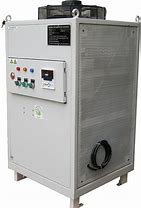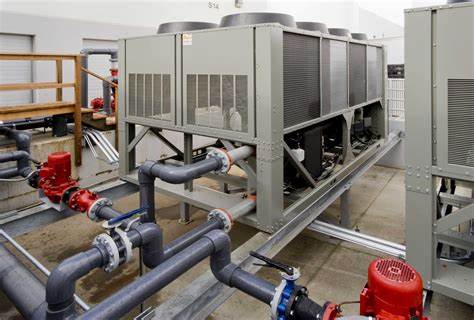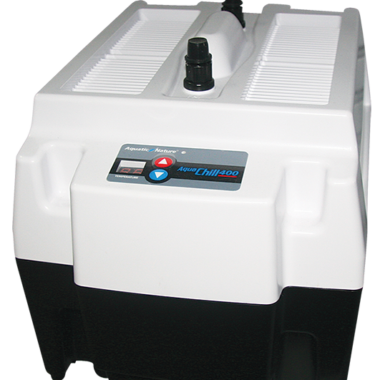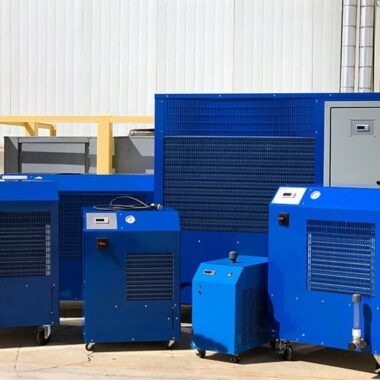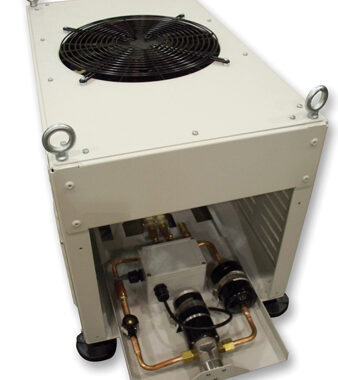Types Of Chiller and Its Usage
Types Of Chiller and Its Usage
Chillers are basic cooling systems utilized in different industrial, commercial, and residential applications. They expel heat from a liquid by means of a vapor-compression or retention refrigeration cycle. Here’s an diagram of the primary types of chiller and its usage particularly:
1. Vapor Compression Chillers
1.1 Air-Cooled Chillers
Description:
- Use encompassing air to dissipate heat from the refrigerant.
- Prepared with fans to encourage air movement over condenser coils.
Advantages:
- Simpler and cheaper to introduce and maintain.
- Reasonable for environments where water is scarce or costly.
Disadvantages:
- Less effective than water-cooled systems.
- Can be noisy due to the fans.
Usage:
- Commercial Buildings: Utilized in HVAC systems for cooling large office buildings, shopping malls, and hospitals.
- Industrial Facilities: Connected in different forms where direct cooling is required, such as plastic extrusion and injection molding.
1.2 Water-Cooled Chillers
Description:
- Utilize water from a cooling tower to dissipate heat from the refrigerant.
- Regularly more proficient than air-cooled systems.
Advantages:
- Higher effectiveness and lower operational costs.
- Quieter operation.
Disadvantages:
- More complex and costly installation.
- Requires a consistent water supply and regular maintenance of cooling towers.
Usage:
- Large Commercial and Industrial Applications: Perfect for high-rise buildings, information centers, and large manufacturing plants.
- Power Generation: Utilized in cooling systems for power plants, counting nuclear and fossil fuel facilities.
2. Absorption Chillers
Description:
- Utilize a heat source (such as steam, hot water, or natural gas) rather than power to drive the cooling process.
- Commonly utilize water and lithium bromide or ammonia as the refrigerant combine.
Advantages:
- Can utilize waste heat, improving in general energy efficiency.
- Suitable for areas with high heat availability and low electricity costs.
Disadvantages:
- Lower efficiency compared to vapor compression chillers.
- More complex and costly to maintain.
Usage:
- Industrial Processes: Where waste heat is accessible, such as in chemical plants and refineries.
- Area Cooling Systems: In large-scale cooling projects where proficiency and sustainability are prioritized.
3. Centrifugal Chillers
Description:
- Utilize a centrifugal compressor to compress the refrigerant, making a cooling effect.
- Known for high capacity and efficiency.
Advantages:
- Tall efficiency and capacity.
- Appropriate for large cooling loads.
Disadvantages:
- High initial cost.
- Complex support.
Usage:
- Huge Commercial Buildings: High-rise office buildings, hotels, and airports.
- Industrial Applications: Large-scale cooling needs in fabricating forms.
4. Screw Chillers
Description:
- Utilize a screw compressor for compressing the refrigerant.
- Known for their reliability and productivity in medium to large applications.
Advantages:
- High efficiency and reliability.
- Better capacity control compared to reciprocating compressors.
Disadvantages:
- Higher starting cost compared to reciprocating chillers.
- More complex maintenance.
Usage:
- Commercial Buildings: HVAC systems for medium to huge buildings.
- Industrial Processes: Utilized in nourishment and beverage preparing, plastic manufacturing, and chemical generation.
5. Scroll Chillers
Description:
- Utilize a scroll compressor to compress the refrigerant.
- Known for their compact measure and quiet operation.
Advantages:
- Quiet and efficient operation.
- Lower maintenance compared to screw and centrifugal chillers.
Disadvantages:
- Limited to smaller capacities.
- Not as productive for very large applications.
Usage:
- Small to Medium-Sized Buildings: HVAC systems for schools, little offices, and retail spaces.
- Industrial Applications: Reasonable for smaller cooling loads in different businesses.
6. Reciprocating Chillers
Description:
- Utilize piston-driven reciprocating compressors.
- Known for their robustness and flexibility.
Advantages:
- Reliable and simple to preserve.
- Suitable for a wide extend of applications.
Disadvantages:
- Lower efficiency compared to screw and centrifugal chillers.
- Noisier operation.
Usage:
- Commercial Buildings: HVAC systems for little to medium-sized buildings.
- Industrial Processes: Utilized in applications requiring reliable and flexible cooling solutions.
Conclusion
The choice of chiller sort depends on a few factors, counting the cooling capacity required, energy efficiency considerations, available resources (such as water or waste heat), and particular application needs. By understanding the different types of chillers and their utilization, industries and businesses can make informed choices to optimize their cooling systems for better execution, effectiveness, and sustainability.
